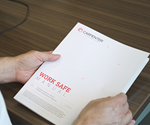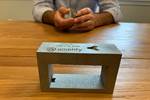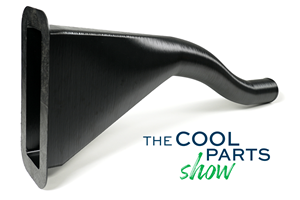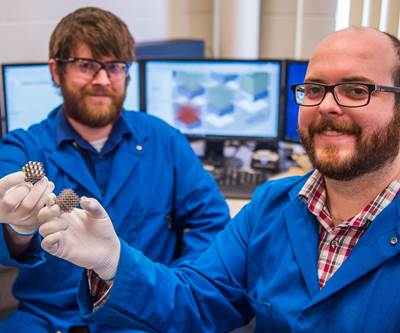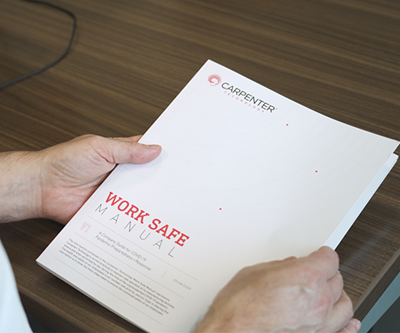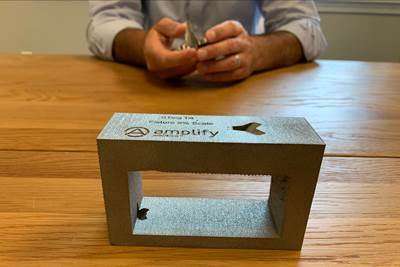When the Perseverance rover lands on Mars in February of 2021, it will carry with it a critical instrument that could not have been produced without additive manufacturing (AM). Launched in July 2020 as part of NASA’s Mars Exploration Program, this mission addresses high-priority science goals for the planet’s exploration, including key astrobiology questions about the potential for life on Mars. The Planetary Instrument for X-ray Lithochemistry, or PIXL, is critical to this mission as it will allow the rover to measure the chemical makeup of rocks at a very fine scale, possibly providing clues about the Red Planet’s ability to support life.
Engineers at the NASA Jet Propulsion Laboratory (JPL) designed the instrument package by focusing 100% on the functionality of the components rather than taking traditional considerations toward manufacturability. Only after the team had the optimal design to carry out the required functions did they consider how to produce the components. The created design included features that prevented traditional manufacturing methods from offering a clear path to production. The JPL team turned to Carpenter Additive hoping to take advantage of the design flexibility afforded by powder bed fusion 3D printing to produce these critical components.
A Function-Focused Design
Like the rest of Perseverance, the PIXL had to be designed to withstand the stress of launch followed by seven months of traveling through frozen space and then a rough landing on Mars. “Touching down on Mars can best be described as a highly engineered, controlled crash landing, and these parts have to withstand that force and then carry out precision experiments,” says Ken Davis, director of additive technology at Carpenter Additive who led the project. Once there, the Mars rover and its instruments will be subject to 2 years of the planet’s hot and cold temperatures, dust storms and rocky terrain. The PIXL itself is located on the end of the cantilever arm on top of the hammer drill, in one of the most extreme positions on the rover.

The PIXL is mounted on the end of Perseverance’s cantilever arm, and will be used to analyze the chemical makeup of rock on the planet’s surface. Image Credit: NASA/JPL-Caltech
The parts produced by Carpenter Additive comprise the housing for the PIXL instrument. There are five 3D printed pieces in total: a large, thin-walled front cover; a deep, thin-walled back cover; a mounting frame with a hollow box beam structure; and a bench and bench support for the X-ray, both hollow, thin-walled brackets. The parts include varying wall thicknesses between 0.040" and 0.045" (1 to 1.1 mm), and complex surfaces that bulge outward in some areas and inward in others, allowing clearance from instruments both within and outside of the PIXL experiment packet. To ensure the components met the no-fail requirements, Carpenter Additive was required to deliver several of each part; a flight component, a test bench component, and one or more additional for destructive testing analysis by NASA.
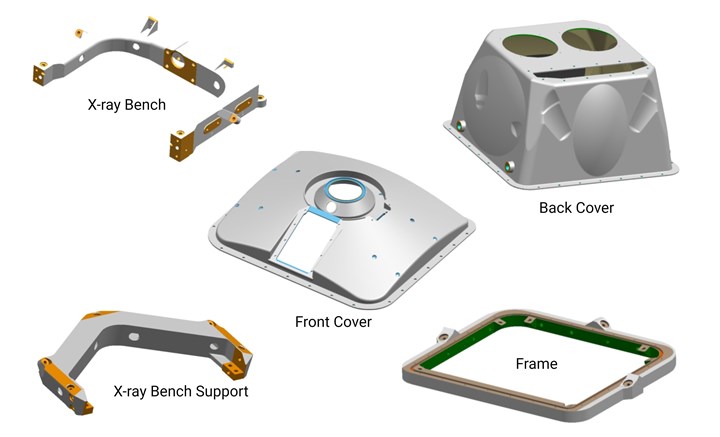
The PIXL housing consists of five 3D printed components: thin-walled front and back covers, a hollow mounting frame, and the bench and support for the X-ray. Images: Carpenter Additive
The PIXL and its housing also had to adhere to an assigned mass budget. All components were collectively required to stay below an absolute weight maximum, otherwise the rover wouldn’t be able to launch. Any exceeding weight on the critical instrument could cause other experiments to be dropped, so mass budget was repeatedly the top consideration when weighing possible design changes throughout the process.
Process Based on Powder-Bed Fusion
Carpenter Additive established a manufacturing plan for the critical PIXL components through additive and subtractive production techniques combined with innovative surface finishing. To build the parts, Carpenter Additive chose to move forward with electron beam powder bed fusion (EB-PBF). Laser powder bed fusion (L-PBF) can typically be considered better at thin walls, fine features and smooth finishes while EB-PBF excels with larger, heavier and thicker parts, but other process advantages led the team to choose the latter.
Because it is a hot process, the electron beam chamber keeps the component packed in powder at a high temperature during the multi-day build and cools slowly over 12 hours, helping to remove residual stresses that could distort fine features. Additionally, as the powder bed itself is semi-sintered through the process, it can act as a support structure during the build. For the PIXL components, this eliminated the need to print attached supports and the risk not meeting the very tight tolerances required by the application specs. “Often, when we evaluate the two technologies there is a clear ‘winner’ for manufacturing, but this was a tight race throughout, with EB-PBF winning by probably an unofficial 52/48 margin,” Davis says.
The mixture of strength and light weight needed dictated the use of titanium, and Carpenter’s Ti 6Al-4V Grade 5+ was chosen for its improved mechanical properties. The material’s higher strength and good ductility provided a minimum 135-ksi yield strength at minimum 15% elongation in the highly stressed, very thin parts.
Following 3D printing, the parts were processed via hot isostatic pressing (HIPing) while still in the powder cake, followed by breakout and support removal, ultrasonic powder removal, chemical milling, mechanical finishing and final machining. 3D scanning inspection played a critical role for the team to verify results after each process step.

Carpenter Additive developed a manufacturing plan that combines additive and subtractive manufacturing processes as well as various other techniques, with inspection at every step. Image Credit: Carpenter Additive
“It was a long journey of mechanical processing followed by inspection, but because of all the fine features we had to know if or how much we were deviating from the final part model to track our path forward,” Davis explains. “We used our hot isostatic press to homogenize the microstructure, but it’s a high temperature process that could distort the part, so we had to go back to the 3D scan. Deburring and grit blasting smooth the surface but can change dimensional features, so we go back in for inspection.”
Challenges in Construction
Expert understanding of each process step plus its potential to introduce deviations from spec, and how each step affects the next, was essential to the successful construction of the part family as the team overcame challenges along the way:
Scale Factors.
The electron beam powder bed fusion process is a complex sequence of heating, expansion, melting, consolidation, solidification and shrinkage. This is not, however, a linear process and the team had to develop scale factors as the average values derived from comparing finished dimensions to model dimensions. Build temperature falls during the initial layers, then recovers during the build while top layer temperatures continue to increase in tall builds. This causes varying part temperatures throughout the build chamber. If these scale factors are not fully understood, and the part designed with this in mind, features may start to grow away from the model and be stretched out of tolerance.
Because components are often rotated within the powder bed for the optimal printing orientation, the parts were not uniformly “scaled” in each orthogonal axis. One axis dimension on the component is a compound of several axes in the printer, so several scale factors of X, Y and Z contribute to the dimensional accuracy. The thin walls of the PIXL parts created a very low thermal mass compared to components typically made with electron beam melting, and proved to be a challenge in re-scaling causing initial parts to be “over scaled” and printed too large. However, learning this lesson on the first part allowed the team to apply the knowledge to the other components, speeding up the iteration process moving forward.
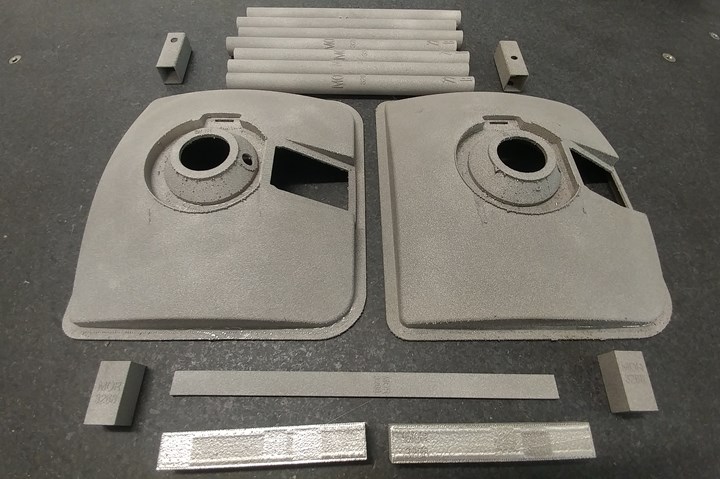
To ensure components met the no-fail requirements, the Carpenter team was required to deliver several of each part; a flight component, a test bench component, and one or more additional for destructive testing analysis by NASA. These two front cover components are on their way to HIPing. Photo Credit: Carpenter Additive
Supports.
Permanent and semi-permanent rigid supports were the focus of much experimentation throughout development. During the powder bed fusion process, supports act as thermal shunts to dissipate heat and allow rapid solidification of the melt pool; they prevent part movement or distortion from thermal stresses; and they support overhanging features. Semi-permanent supports were employed to protect parts through several postprocessing operations to prevent the distortion of thin-walled structures during HIPing, allow for clamping during the machining of critical surfaces and to hang parts in chemical milling.
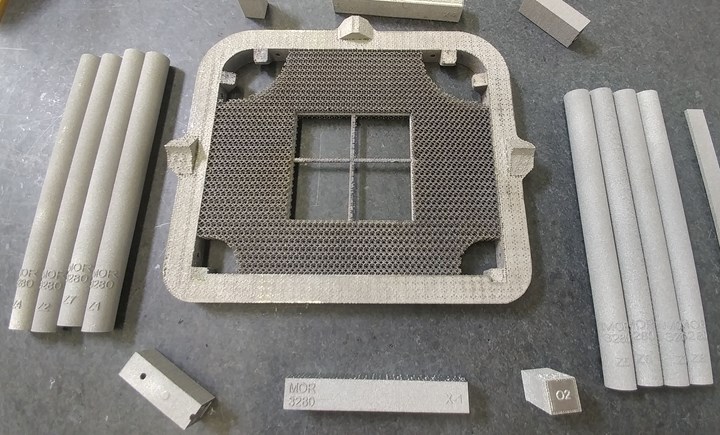
A semipermanent support structure was added to some parts like the PIXL frame to support the pieces during postprocessing steps. Photo Credit: Carpenter Additive
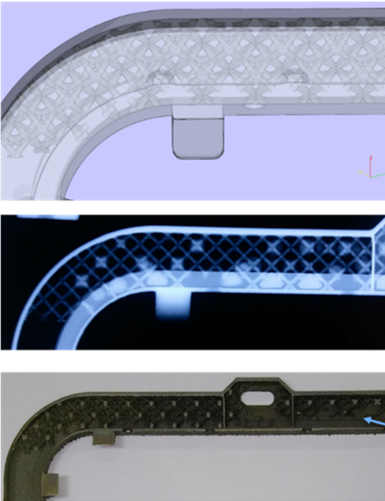
These X-ray images show several variations of lattice size and wafer supports tested within the box beams of the frame. Image Credit: Carpenter Additive
The box beams of the frame created a challenge because, regardless of orientation, one beam would always be perfectly horizontal requiring the top surface to be supported inside the hollow design. However, the design only allowed for 5-mm extraction holes for any internal material. After much experimentation with removable options, permanent supports were integrated into the design with the concession of a few grams to the mass budget. A lattice structure was 3D printed on one leg of the frame after experimentation and optimization of the lattice to ensure it would survive printing, machining and its mission on Mars. The results determined by experimentation on the box beams were important for the much larger frame component, again allowing the team to speed up their iterations through lessons learned.
Powder Removal.
Extraction of any residual powder is critical to avoid introducing a potential source of foreign object damage (FOD). The design of the hollow X-ray bench support provided only small holes as access to internal powder. No changes to the size or location of the holes was possible since their design was dictated by the load path, so an advanced powder extraction technique was required.
Utilizing ultrasonic powder extraction, where a transducer on component finds the natural frequency of the internal powder cake to break it apart for removal, the team was able to extract an additional 156 grams of powder after already completing aggressive mechanical powder removal. The ultrasonic process, however, introduced its own challenges as the natural frequency of the powder cake changes continually as it breaks apart, requiring re-tuning to chase the natural frequency until all powder is broken apart and removed.
Chemical milling, used for several purposes including surface finish improvements and wall thinning, also flushed hollow components to ensure all residual powder was removed.
Final Components en Route to Mars
The PIXL components were the most challenging Carpenter Additive had encountered. A part re-design was not possible, and tolerances could not be opened due to the critical mass budget. A total of 0.077 oz (22 grams) was ultimately added to the 16-pound (7.26 kg) construction, within the margins to improve manufacturability.

In addition to the high precision needed from the additive parts, the PIXL components also required very precise, fine machined details with 0.005" (0.127 mm) true position tolerances and a surface finish of 32 microinch Ra. NASA/JPL-Caltech
The team at Carpenter Additive was successful at developing the final assembly components within the defined parameters, although many iterations were required along the way as even additive manufacturing faces challenges on the long path to manufacturability. The demanding journey was completed in 18 months rather than the hoped-for six, as the team iterated to fail fast, learn and establish new best practices from these successions, and implement improvements at every stage of production from material selection and printing to inspection and machining.
By February 2021, these components will arrive on Mars to support mission-critical, pioneering measurements of the chemical makeup of our neighboring Red Planet.
Related Content
Aircraft Ducts 3D Printed in Composite Instead of Metal: The Cool Parts Show #68
Eaton’s new reinforced PEKK, tailored to aircraft applications, provides a cheaper and faster way to make ducts compared to formed aluminum.
Read MoreHow Norsk Titanium Is Scaling Up AM Production — and Employment — in New York State
New opportunities for part production via the company’s forging-like additive process are coming from the aerospace industry as well as a different sector, the semiconductor industry.
Read MoreAdditive Manufacturing Is Subtractive, Too: How CNC Machining Integrates With AM (Includes Video)
For Keselowski Advanced Manufacturing, succeeding with laser powder bed fusion as a production process means developing a machine shop that is responsive to, and moves at the pacing of, metal 3D printing.
Read MoreBeehive Industries Is Going Big on Small-Scale Engines Made Through Additive Manufacturing
Backed by decades of experience in both aviation and additive, the company is now laser-focused on a single goal: developing, proving and scaling production of engines providing 5,000 lbs of thrust or less.
Read MoreRead Next
Additive Manufacturing Moves Toward Tailored Materials
A conversation with Carpenter Technology suggests that AM is moving past existing materials toward specialized and eventually fully custom options. The company’s CarTech Puris 5+ titanium powder is one illustration.
Read MoreVideo: Carpenter Technology’s Company-Wide Response to COVID-19
Here are tactics the company has put in place to keep its team members safe as production continues despite the threat of the coronavirus. (Sponsored)
Read MoreWith This 3D Printed Block, EBM Is an Aid to CNC Machining
Holding the part is a challenge of machining for additive manufacturing. This medical manufacturer prints fixture tooling tailored to its additive parts.
Read More


